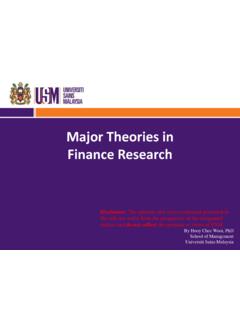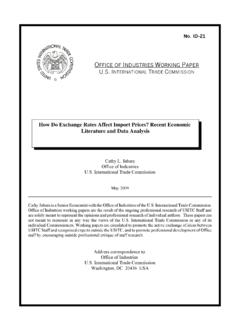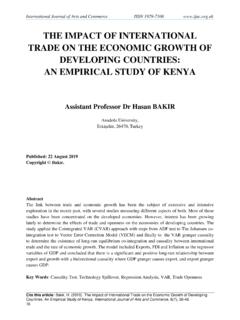Transcription of International Trade and Exchange Rate
1 International Trade . AND Exchange RATE. Jong Woo Kang NO. 498 adb economics october 2016 working paper series ASIAN DEVELOPMENT BANK. ADB Economics Working Paper Series International Trade and Exchange Rate Jong Woo Kang Jong Woo Kang is principal economist at the Economic Research and Regional Cooperation No. 498 | October 2016 Department, Asian Development Bank. I am grateful to Suzette Dagli for excellent research assistance. Creative Commons Attribution IGO license (CC BY IGO). 2016 Asian Development Bank 6 ADB Avenue, Mandaluyong City, 1550 Metro Manila, Philippines Tel +63 2 632 4444; Fax +63 2 636 2444. Some rights reserved. Published in 2016. Printed in the Philippines. ISSN 2313-6537 (Print), 2313-6545 (e-ISSN). Publication Stock No. WPS168472-2. Cataloging-In-Publication Data Asian Development Bank.
2 International Trade and Exchange rate. Mandaluyong City, Philippines: Asian Development Bank, 2016. 1. Gravity model. 2. Real effective Exchange rate. 3. Trade volume. I. Asian Development Bank. The views expressed in this publication are those of the authors and do not necessarily reflect the views and policies of the Asian Development Bank (ADB) or its Board of Governors or the governments they represent. ADB does not guarantee the accuracy of the data included in this publication and accepts no responsibility for any consequence of their use. The mention of specific companies or products of manufacturers does not imply that they are endorsed or recommended by ADB in preference to others of a similar nature that are not mentioned. By making any designation of or reference to a particular territory or geographic area, or by using the term country.
3 In this document, ADB does not intend to make any judgments as to the legal or other status of any territory or area. This work is available under the Creative Commons Attribution IGO license (CC BY IGO). By using the content of this publication, you agree to be bound by the terms of this license. This CC license does not apply to non-ADB copyright materials in this publication. If the material is attributed to another source, please contact the copyright owner or publisher of that source for permission to reproduce it. ADB cannot be held liable for any claims that arise as a result of your use of the material. Attribution You should always acknowledge ADB as the source using the following format: [Author]. [Year of publication]. [Title of the work in italics]. [City of publication]: [Publisher].
4 ADB. [URL or DOI]. [license]. Translations Any translations you create should carry the following disclaimer: Originally published by ADB in English under the title [title in italics]. ADB. [URL or DOI] [license]. The quality of the translation and its coherence with the original text is the sole responsibility of the translator. The English original of this work is the only official version. Adaptations Any adaptations you create should carry the following disclaimer: This is an adaptation of an original work titled [title in italics]. ADB. [URL or DOI][license]. The views expressed here are those of the authors and do not necessarily reflect the views and policies of ADB or its Board of Governors or the governments they represent. ADB does not endorse this work or guarantee the accuracy of the data included in this publication and accepts no responsibility for any consequence of their use.
5 Please contact if you have questions or comments with respect to content, or if you wish to obtain copyright permission for your intended use that does not fall within these terms, or for permission to use the ADB logo. Notes: 1. In this publication, $ refers to US dollars. 2. Corrigenda to ADB publications may be found at CONTENTS. TABLES AND FIGURES iv ABSTRACT vi I. INTRODUCTION 1. II. CHANGING TRENDS IN Trade GROWTH 1. A. Trade Volume Growth 1. B. Role of Developed and Developing Countries in International Trade 3. III. IMPACT OF Exchange rates ON Trade GROWTH 7. A. Exchange Rate Movements and Their Impact on Trade 7. B. Decomposition of Factors Affecting Sluggish Trade Growth 10. C. Impact of Exchange rates on Trade Volumes 15. IV. CONCLUSION 19. APPENDIXES 21. BIBLIOGRAPHY 23.
6 TABLES AND FIGURES. TABLES. 1 Factor Decomposition of Trade Volume Growth between 2006 and 2015 15. 2 Gravity Model Estimation Results (2001 2015) under Base Model 16. 3 Gravity Model Estimation Results under Base Model (2003 2006 versus 2007 2010 versus 2012 2015) 17. 4 Gravity Model Estimation Results (2001 2015) under Extended Model 18. 5 Gravity Model Estimation Results under Extended Model (2003 2006 versus 2007 2010 versus 2012 2015) 19. FIGURES. 1 Trade Volume 2. 2 Growth Difference 2. 3 Asia 2. 4 World 2. 5 Trade Volume Growth ( Trade weighted) 3. 6 Growth Difference 3. 7 Trade Volume Growth (developed) 4. 8 Trade Volume Growth (developing) 4. 9 Trade Volume Growth (developed, Trade weighted) 4. 10 Trade Volume Growth (developing, Trade weighted) 4. 11 Export Volume Growth 5.
7 12 Import Volume Growth 5. 13 Export Volume Growth ( Trade weighted) 5. 14 Import Volume Growth ( Trade weighted) 5. 15 Export Volume Growth (simple average, developing world versus developing Asia) 6. 16 Import Volume Growth (simple average, developing world versus developing Asia) 6. 17 Export Volume Growth ( Trade -weighted average, developing world versus developing Asia) 6. 18 Import Volume Growth ( Trade -weighted average, developing world versus developing Asia) 6. 19 REER Index, 2001 2006 7. 20 REER Index, 2012 2015 7. 21 Standard Deviation of REER 8. 22 REER Elasticity of Export Volume 8. 23 REER Elasticity of Import Volume 8. 24 Trade Volume Growth depreciation, 2001 2006 9. 25 Trade Volume Growth appreciation, 2001 2006 9. 26 Trade Volume Growth depreciation, 2012 2015 10. 27 Trade Volume Growth appreciation, 2012 2015 10.
8 28 Trade Volume depreciation, 2001 2006 10. 29 Trade Volume appreciation, 2001 2006 10. 30 Trade Volume depreciation, 2012 2015 11. 31 Trade Volume appreciation, 2012 2015 11. 32 REER versus Export Volume, 2001 2006 11. 33 REER versus Import Volume, 2001 2006 11. 34 REER versus Export Volume, 2012 2015 12. 35 REER versus Import Volume, 2012 2015 12. 36 Counterfactual versus Actual depreciation, 2012 2015 13. 37 Counterfactual versus Actual appreciation, 2012 2015 13. 38 Counterfactual versus Actual depreciation, 2001 2006 14. 39 Counterfactual versus Actual appreciation, 2001 2006 14. World Export Volume (2010=100) 21. World Import Volume (2010=100) 21. World Export Value (2010=100) 21. World Import Value (2010=100) 21. ABSTRACT. Tepid Trade growth since the 2008/2009 global financial crisis (GFC) has been partly attributed to sluggish demand from developed countries.
9 However, data reveals that developing countries play a bigger role in holding back Trade growth, while developed countries show quite robust import growth. Post-GFC, the Exchange rate volatility has grown significantly. As decomposion of country groups by changes in currency valuation shows, however, local currency depreciation is not contributing to export growth as much as conventional wisdom dictates. On the other hand, countries with appreciating currencies show rising import intensity and significant export growth. This implies that the more countries undergo currency devaluation the deeper the degree of devaluation and even competitive devaluations the more likely International Trade will grow slower. Keywords: gravity model, real effective Exchange rate, Trade volume JEL codes: C23, F10, F31.
10 I. INTRODUCTION. After a short period of quick recovery following the 2008/2009 global financial crisis (GFC), there have been protracted periods of slumping world Trade growth. What bewilders policy makers and academia alike is that not only Trade value has stagnated significantly affected by volatile and low commodity prices, especially oil but Trade volume seems to have stagnated as well. Pre-GFC, global Trade growth outpaced gross domestic product (GDP) growth Trade growth from 1990 to 2008. averaged , while GDP grew Since the GFC, however, global Trade volume growth averaged behind the global GDP growth (World Economic Outlook 2015, International Monetary Fund;. International Trade Statistics 2015, World Trade Organization). Historically then, the GFC posits an important structural change in the pattern of global Trade .















